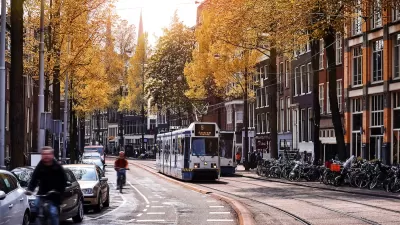Despite many studies confirming the effect of induced traffic, the effect is often ignored in the transport models used for project appraisal, says a team of Scandanavian researchers creating an extreme bias in the assessment of new projects.
Induced traffic, for those not in the know, is, according to StreetsWiki, is "the phenomenon whereby decreasing the cost of vehicle trips in a particular corridor -- usually by decreasing congestion through a roadway improvement -– induces new vehicle trips in that corridor."
A new research paper from professors at Aalborg University in Denmark and the Institute of Transport Economics in Norway says that the cost-benefit analyses for new roads in Europe still suffer from a lack of recognition for the induced traffic phenomenon:
"By exaggerating the economic benefits of road capacity increase and underestimating its negative effects, omission of induced traffic can result in over-allocation of public money on road construction and correspondingly less focus on other ways of dealing with congestion and environmental problems in urban areas," according to the report summary.
The effect is illustrated through a case study of a new road project in Copenhagen, where a more sophisticated representation of travel behaviour resulted in 40% less benefits compared to traditional approaches. The researchers argue for transport models to focus more on pedagogy than precision, to reduce the risk of policy makers misleading both themselves and the public.
The full report is available as a free PDF download.
Thanks to Morten Skou Nicolaisen
FULL STORY: Traffic Forecasts Ignoring Induced Demand: a Shaky Fundament for Cost-Benefit Analyses

Study: Maui’s Plan to Convert Vacation Rentals to Long-Term Housing Could Cause Nearly $1 Billion Economic Loss
The plan would reduce visitor accommodation by 25,% resulting in 1,900 jobs lost.

North Texas Transit Leaders Tout Benefits of TOD for Growing Region
At a summit focused on transit-oriented development, policymakers discussed how North Texas’ expanded light rail system can serve as a tool for economic growth.

Using Old Oil and Gas Wells for Green Energy Storage
Penn State researchers have found that repurposing abandoned oil and gas wells for geothermal-assisted compressed-air energy storage can boost efficiency, reduce environmental risks, and support clean energy and job transitions.

Santa Barbara Could Build Housing on County Land
County supervisors moved forward a proposal to build workforce housing on two county-owned parcels.

San Mateo Formally Opposes Freeway Project
The city council will send a letter to Caltrans urging the agency to reconsider a plan to expand the 101 through the city of San Mateo.

A Bronx Community Fights to Have its Voice Heard
After organizing and giving input for decades, the community around the Kingsbridge Armory might actually see it redeveloped — and they want to continue to have a say in how it goes.
Urban Design for Planners 1: Software Tools
This six-course series explores essential urban design concepts using open source software and equips planners with the tools they need to participate fully in the urban design process.
Planning for Universal Design
Learn the tools for implementing Universal Design in planning regulations.
Ascent Environmental
Borough of Carlisle
Institute for Housing and Urban Development Studies (IHS)
City of Grandview
Harvard GSD Executive Education
Toledo-Lucas County Plan Commissions
Salt Lake City
NYU Wagner Graduate School of Public Service





























